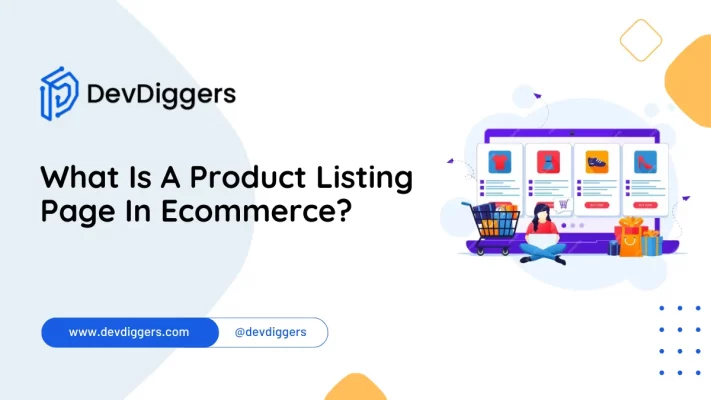Maximizing SEO Impact: The Importance of a Hybrid Ecommerce Platform

In today’s dynamic retail world, a new paradigm is reshaping the way we shop – a hybrid eCommerce platform. This innovative approach seamlessly merges the convenience of digital shopping with the sensory experience of traditional retail, promising a flexible and enriched journey for shoppers.
Table of Contents
What is Hybrid Ecommerce Platform?
A hybrid eCommerce platform, often known as omnichannel retailing, involves integrating online and offline sales channels within the retail sector.
It empowers businesses to effectively manage both digital platforms like websites and mobile apps, alongside physical brick-and-mortar stores, delivering customers a cohesive and integrated shopping adventure.
At its essence, a hybrid eCommerce platform liberates customers to interact with a brand or retailer through diverse channels.
Whether customers seek the ease of online browsing or the hands-on involvement of in-store shopping, this allows them to explore products online, place orders for delivery, or opt for a visit to a physical store.

Advantages of Hybrid Ecommerce Platform
- Enhanced Customer Journey: A hybrid eCommerce platform prioritizes the customer journey. It ensures a uniform brand interaction across online and offline touchpoints, enabling customers to switch effortlessly between them. Whether a customer initiates their journey online and completes it in-store or vice versa, the aim is a unified and satisfying shopping experience.
- Expanded Reach and Unmatched Flexibility: The integration of online and offline channels broadens the horizons and caters to diverse shopping preferences. This adaptability allows customers to shop on their terms, whether from the comfort of their homes or through an in-person visit. It opens up new avenues for engaging with various customer segments.
- Efficient Inventory Management: Efficient inventory management is a cornerstone of hybrid eCommerce. Synchronizing inventory across all sales channels enables retailers to manage stock levels effectively, reducing overstocking or understocking challenges. Real-time updates on product availability ensure customers have accurate information, enhancing their overall shopping experience.
- Seamless Multichannel Transactions: This platform facilitates a seamless multichannel sales approach. Customers can initiate their shopping journey online, add desired items to their cart, and choose to finalize the purchase either online or at a nearby physical store. Similarly, they can start in-store and complete the transaction online, embracing a truly integrated approach.
- Insights Driven by Data: The marriage of a hybrid eCommerce platform with data analytics yields valuable customer insights. Retailers can track consumer behavior, preferences, and purchasing patterns across various channels. These insights empower businesses to tailor marketing strategies, refine product offerings, and enhance customer engagement strategies.
Essential Features of Hybrid Ecommerce Platform

Hybrid eCommerce Platform, the exciting blend of online and offline shopping experiences, incorporates several distinctive features that make it stand out in the retail landscape. Here’s a user-friendly breakdown of these key aspects:
- Seamless Fusion of Online and Offline: Hybrid eCommerce platform seamlessly marries the digital world (websites, mobile apps) with traditional brick-and-mortar stores, providing customers with a cohesive shopping experience that can transition seamlessly between online and in-store.
- Consistent Brand Experience: Customers enjoy a consistent brand experience across all touchpoints, be it online or in-store. This uniformity ensures customers feel the same essence and quality of the brand, enhancing overall satisfaction.
- Omnichannel Presence: It strives to provide an omnichannel retail experience. Customers can fluidly shift between online and offline shopping while maintaining a unified brand identity and service level.
- Efficient Inventory Management: By integrating inventory management systems, this platform ensures that stock levels are accurately tracked across all channels. This reduces the risk of overstocking or running out of popular products.
- Flexible Shopping and Delivery Choices: Customers have the freedom to initiate a purchase online and finalize it in a physical store, or the other way around. Additionally, they can opt for home delivery or pick up their orders in-store, catering to their preferences and schedules.
- Real-time Data Harmony: The hybrid model ensures that customer data, product availability, and sales information are continuously updated in real-time across all channels, offering a dynamic and informed shopping experience.
- Smooth Channel Transition: Customers can start their shopping journey online, explore products, and seamlessly transition to a physical store, or vice versa. This fluidity provides a seamless and enjoyable shopping experience.
- Personalized Shopping Experience: Data insights from both online and offline interactions empower businesses to personalize their offerings and promotions, tailoring them to the unique preferences and behaviors of individual customers.
- Integrated Marketing Strategies: This supports marketing strategies that span both online and offline channels, amplifying the reach and impact of marketing efforts for increased customer engagement and higher sales.
- Flexibility to Grow and Adapt: The hybrid model is designed to evolve and scale with a business, easily adapting to changing market conditions and accommodating business expansion while maintaining its seamless integration.
These features collectively define the essence of a hybrid eCommerce platform, highlighting its ability to bridge the gap between the digital and physical retail worlds, providing customers with a comprehensive and enriched shopping adventure.
Success Stories: Hybrid Ecommerce Platform in Action
A hybrid eCommerce platform, the perfect marriage of online and offline shopping experiences, has proven its worth through numerous success stories. Let’s delve into some remarkable case studies that underscore the effectiveness and benefits of this retail approach.
Nike: Bridging the Gap Seamlessly
Nike, a global sports retail giant, exemplifies a successful hybrid eCommerce platform strategy.
They seamlessly integrated their online store with their physical outlets, providing customers the flexibility to browse and customize shoes online and either have them delivered or visit a store for a personalized experience.
This approach significantly increased overall sales and customer satisfaction, showcasing the prowess of this platform in the retail industry.
Walmart: Elevating Convenience and Reach
Walmart, a retail behemoth, embraced a hybrid eCommerce platform by integrating its vast online platform with an extensive network of physical stores.
Features like ‘Order Online, Pickup In-Store’ (BOPIS) and ‘Scan & Go’ were introduced, allowing customers to effortlessly transition between online and in-store shopping.
This strategy substantially boosted their online sales while using their extensive store network, providing unparalleled convenience to their customers.
Warby Parker: A Harmonious Blend of Channels
Warby Parker, a prominent eyewear retailer, is a prime example of a successful hybrid eCommerce strategy.
They offer an online platform where customers can virtually try on glasses and make purchases. Additionally, they have physical stores where customers can experience a personalized fitting.
The seamless integration of these channels significantly enhanced their brand visibility and customer engagement, showcasing how the perfect blend of online and offline can thrive in the eyewear industry.
Amazon Go: Merging Technology and Retail
Amazon Go, the cashier-less store concept, stands as a testament to how technology complements hybrid eCommerce platforms.
Customers can simply enter the store, pick up items, and leave without the need for traditional checkout. The purchases are automatically charged to their Amazon accounts.
This groundbreaking approach has revolutionized the retail landscape, demonstrating the power of technology in providing a seamless and efficient shopping experience.
Lululemon: Amplifying In-store Experience with Digital
Lululemon, a popular athletic apparel retailer, has effectively utilized this model to enhance its in-store experience.
They offer in-store events and classes while utilizing their website to provide information and register customers for these events.
This fusion of digital and in-person engagement has significantly strengthened their brand community and increased foot traffic to their physical stores.
These success stories highlight the adaptability and effectiveness of hybrid eCommerce platforms in meeting customer needs, enhancing convenience, and driving business growth. This presents a promising future for retailers seeking to integrate the best of both online and offline retail experiences.
Implementing Hybrid Ecommerce Platform: A Guide to Success

Successfully implementing a hybrid eCommerce platform model requires a strategic and well-planned approach. Let’s explore a guide to help businesses seamlessly integrate online and offline experiences into a cohesive and effective retail strategy.
Step 1: Comprehensive Market Research:
Begin by conducting thorough market research to understand your target audience, their preferences, and behaviors.
Analyze the market trends and competitor strategies to identify opportunities and potential gaps that a hybrid model can address.
Step 2: Identify Integration Points:
Determine how online and offline channels will integrate.
This may include inventory synchronization, customer data consolidation, and a unified shopping cart that operates across all platforms. Smooth integration is key to a seamless customer experience.
Step 3: Invest in Technology:
Utilize advanced technology solutions for efficient management of both online and offline operations.
Implement a robust eCommerce platform, integrate a reliable point-of-sale system, and incorporate customer relationship management (CRM) software to manage customer data effectively.
Step 4: Optimize Inventory Management:
Integrate your inventory management system to ensure real-time updates across all channels.
This helps in preventing over-selling, improves accuracy, and provides customers with up-to-date product availability information.
Step 5: Unified Customer Experience:
Ensure a consistent and unified experience for customers across all touchpoints. Whether they engage online or in-store, maintain a cohesive brand identity, pricing, and promotions.
Train staff to provide a seamless experience during in-store visits.
Step 6: Seamless Order Fulfillment:
Offer flexible order fulfillment options such as ‘Buy Online, Pickup In-Store’ (BOPIS) or ‘Buy In-Store, Ship to Home’.
Make the process smooth and convenient for customers, encouraging them to utilize both channels effortlessly.
Step 7: Personalized Marketing Strategies:
Utilize customer data collected from both online and offline interactions to create personalized marketing campaigns.
Tailor promotions, offers, and product recommendations to individual preferences to enhance engagement and drive sales.
Step 8: Staff Training and Education:
Train your staff to understand and adapt to the hybrid model.
They should be knowledgeable about both online and offline offerings, capable of assisting customers with online orders and enhancing the overall shopping experience.
Step 9: Gather and Analyze Data:
Regularly collect data on customer behavior, sales, and preferences from both online and offline channels.
Analyze this data to make informed business decisions, optimize strategies, and continuously improve the hybrid eCommerce model.
Step 10: Customer Feedback and Adaptation:
Seek feedback from customers regarding their experience with the hybrid model.
Use this feedback to make necessary adjustments and improvements, ensuring the model aligns with evolving customer expectations.
By following these steps and staying attuned to customer needs and market trends, businesses can successfully implement a hybrid eCommerce strategy. This integration empowers retailers to offer a holistic shopping experience that combines the best of both digital and traditional retail.
Conclusion
Paving the Way to the Future: Hybrid Ecommerce Platform Leading the Charge
In a world where technology advances at an unprecedented pace and consumer expectations constantly evolve, a hybrid eCommerce platform emerges as the guiding light for the future of retail.
It strikes a harmonious balance between digital ease and the tangible experience of traditional retail, benefiting both customers and retailers.
To successfully embrace hybrid eCommerce, a comprehensive approach that embraces innovative technologies and strategies is vital.
As businesses continue to unlock the potential of this model, they will redefine the retail landscape, offering customers an unparalleled and delightful shopping experience that seamlessly integrates the best of both worlds. The future of retail is here, and it’s hybrid.
Hybrid Ecommerce Platform: Bridging the Gap to Tomorrow’s Retail
A hybrid eCommerce platform is not just a concept; it’s a transformative bridge to the future of retail.
This innovative approach stands as a testament to the adaptability and resilience of the retail industry in the face of an ever-evolving digital landscape.
As technology continues to advance, this will undoubtedly evolve and set new benchmarks. It’s a dynamic fusion, a convergence of the traditional and the modern, offering a holistic shopping experience to consumers.
The future of retail is indeed hybrid, and businesses that embrace this evolution are well-positioned to lead the way in the retail landscape of tomorrow.




